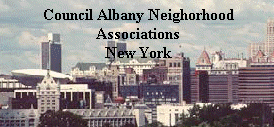As chairman of the Council of Albany Neighborhood Associations during
Tom Whalen's 12 years in public office (his two years as president of
the Common Council and 10 years as mayor), I offer a somewhat different
point of view than that expressed by Paul Bray in his Dec. 12 column
dealing with recent mayors as having a patroon mentality.
During the Corning years, neighborhood associations were tolerated at
best. While Mayor Corning would address neighborhood association
meetings, we always felt that it was a form of noblesse oblige. All
requests for city services had to go directly to the mayor since
department heads apparently were not permitted to deal directly with the
public, or chose not to do so.
While we were often advised to seek help from local committeemen,
neighborhood associations did not take this route since we felt that
public services were to be provided by government as a right and not as
a favor by the political party in power.
Accordingly, there was a disconnect between city residents involved
in nonpartisan neighborhood associations and city government, as
represented by Mayor Corning.
There was a change in attitude once Tom Whalen became Common Council
president in 1982, when he agreed to address the January meeting of CANA
and to respond to questions following his prepared remarks. Those in
attendance viewed the meeting very favorably. Whalen continued to
address CANA's January meetings, the following year as Common Council
president, and for 10 years as mayor. (Mayor Jerry Jennings has
continued this practice of addressing CANA's first meeting of the year.)
The mayor's addresses came to be viewed as a "State of the City''
report and were often covered by the media because of the tough
questions posed by CANA delegates.
Tom Whalen said he found these meetings to be most useful, and he
encouraged department heads to meet with CANA. When one department head
was reluctant to accept a CANA invitation to speak, a telephone call to
the mayor resulted in an acceptance. Virtually every department head met
with CANA at least once over the years, and several spoke more
frequently, subjecting themselves to a wide range of questions. In
addition, city officials became active participants in the various
neighborhood conventions that took place during the Whalen era.
Among Tom Whalen's early appointments after taking office, upon the
death of Mayor Corning, were two experienced public officials, Dan
Klepak as budget director and Michael Haydock as buildings commissioner.
These appointments, and other actions, indicated that the mayor was
responsive to neighborhood association concerns.
I could list many other city activities where Tom Whalen encouraged
neighborhood association input and participation. The bottom line is
that rather than tolerating neighborhood associations, Mayor Whalen
viewed them as an asset to the city, consisting of people who worked to
improve the quality of life in the community in which they lived. While
he did not accept all of our proposals, including a much-delayed
citywide real property reassessment, we always had an opportunity to
have a hearing on our concerns.
HAROLD RUBIN
Albany
